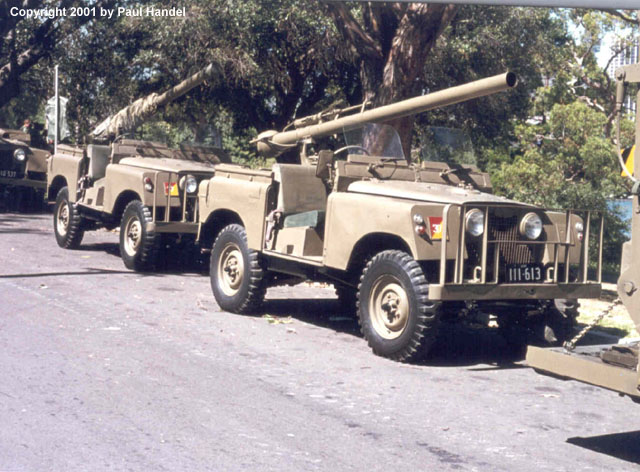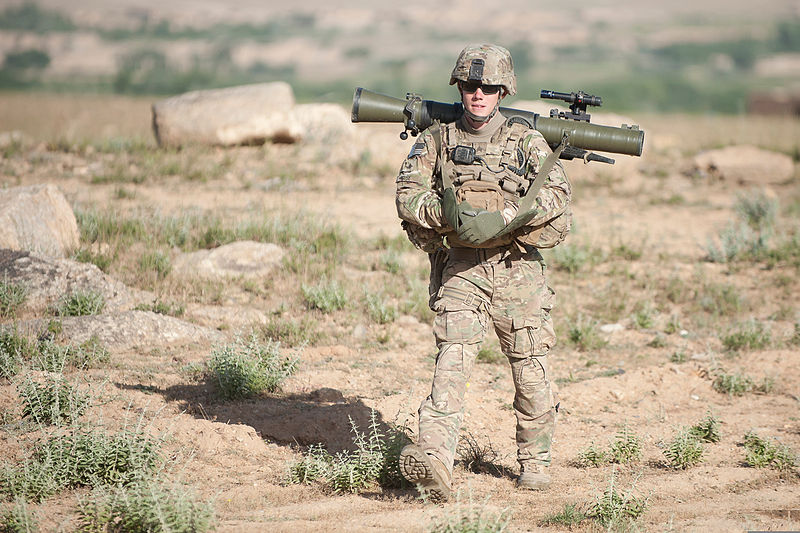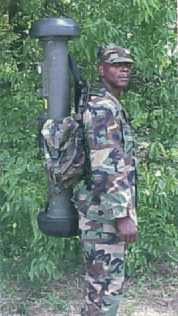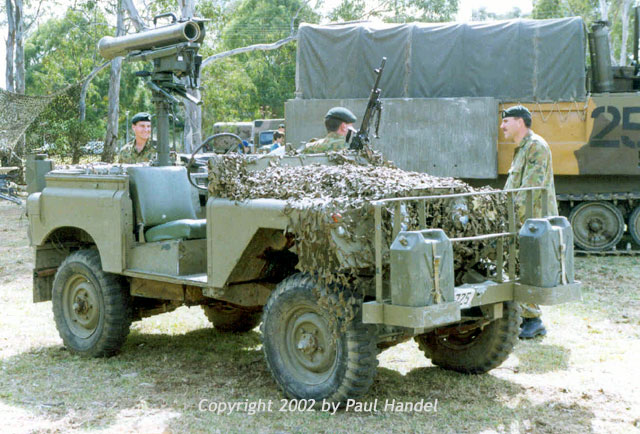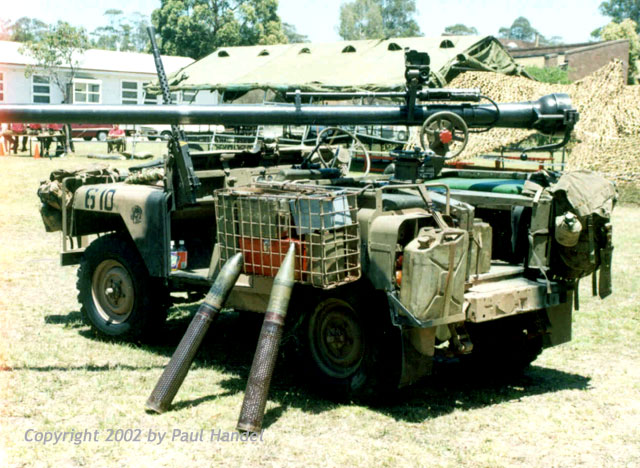"A man with a Carl Gustav who hides is simply useless " unless you are ironman or superman in a battle you have to hide if a situation arises and struck enemy at the time and position suited to you most.
"If he fires, he will be spotted" bro a rpg ,carl or jave is a "dengu mosquito" loaded for kill and hard to detect where as rcl mounted on jeep is a dog coming at you when you are "armed" easier to detect and kill and even if it bite not fatal in most cases.
"Every weapon has an optimum usage profile" rcl mounted on vehicle is nothing but a light artillery mounted on jeep with limitation and venerability of artillery .best used from well defended or safe areas not in active battlefield crawling with enemy.rcl on vehicle can be destroyed by a well aimed grenade or a short burst of automatic fire as it,s easy to finish it,s crew which is always exposed where as carl or rpg can be fired from cover.
" I wonder why armies still use light, fast, wheeled armed vehicles and not just men carrying stuff." you know most of these vehicles are armored and and if not and faced with enemy with rpg or good firepower they just are sitting duck.
do you know why not rcl on jeep because "extreme firing signature (firing one round revealed your almost fully exposed position to anybody in sight), extreme back blast hazard, second degree breech burns, smashed fingers and toes, MULE rollovers, open breech cookoffs, permanent hearing loss even with ear plugs, high incidence of warhead skip and ricochet, on and on ..." and this i am quoting someone who has actually used them.
i am not saying it's not a weapon .it is a weapon but what i meant to say is that "what would you prefer if all these are available to yo rcl mounted on jeep,carl,rpg,javelin,spike" here "prefer" being the word cause if the need arise and with no option you will go to a war with whatever is available but what i fail to understand is that what logic is there in using this
when you can have this
which is more light more versatile more adaptable more accurate more practical more ergonomic..........if a personal choice i would say:thumb: go ahead but if you try to say a logical choice i would say


now lets here actual fact about man portable rpg in real battles
Most Valuable Weapon: the RPG
By Gary Brecher Browse author Email
Browse column
"The weapon of choice for the Iraqi resistance is the rocket propelled grenade (RPG)-7."
George J. Mordica II
USA Center for Army Lessons Learned
If you've been reading my columns for a while, you probably noticed I don't talk military hardware as much as most war buffs. There are a lot of people who'll talk all day about whether the Russian T-90 or the US Abrams is the best MBT. I don't do that much, for the simple reason that wars these days don't come down to one model of tank vs. another. It's pretty rare to find a war where both sides even use tanks. Most of the time it's guerrilla vs. guerrilla, or conventional army vs. guerrilla. The odds of an all-out hi-tech war between two conventional armies like the US and Russia are about...oh, zero-point-zero. So it just doesn't matter that much whether their tanks could beat ours in some make-believe replay of the Kursk Salient. If you want to play that kind of war, buy a computer game. God knows there's enough of them. If you want to know how people make war now, in the real world, you need to study people, not hardware.
Sad but true, boys: war these days is more like Social Studies than Metal Shop. It's about tribal vendettas, military intelligence, propaganda, money -- just about everything except pure hardware.
Don't get me wrong, I love the hardware as much as anybody. I used to spend every free hour, back before there was an internet, going over those big heavy reference books in the library: Jane's Tanks, Jane's Missile Systems, Jane's Combat Vehicles. I had those things memorized. Seriously, you could open any of Jane's handbooks at random, read me the name of a weapons system, and I'd recite its stats from memory -- Norwegian anti-ship missiles, South African APCs, you name it.
But eventually I had to face the facts: most of those weapons are never going to get used. If you look at all the real wars going on right now, you come across the same two weapons, over and over: the AK-47 and the RPG-7 -- both Russian designs, and both older than your Dad.
They're the weapons that matter, because they're already out there, millions of units, enough to equip every guerrilla army in the world, simple enough that you can teach a peasant kid with hookworm and a room-temperature IQ to fire them, and cheap enough to buy in bulk.
And the RPG is the best of all, even better than the Kalashnikov. This simple little beauty just keeps getting more and more effective. This cheap little dealie, nothing but a launcher tube and a few rockets shaped like two ice-cream cones glued together, has kicked our ass (and Russia's too) all over the world since back when the Beatles were still together. In fact, more and more guerrilla armies are making the RPG their basic infantry weapon, with the AK used to protect the RPG gunners, who provide the offensive punch. The Chechens fighting the Russian Army are so high on it that they've switched their three-man combat teams from two riflemen and an RPG gunner to two RPG gunners with a rifleman to protect them.
There's another stat that's even more important right now: the RPG has inflicted more than half -- half! -- of US casualties in Iraq. This is the weapon that's hurting us. And it's been doing that for one hell of a long time.
The Soviets created the RPG for use by Soviet infantry squads against US tanks, APCs and personnel in that big NATO/Warsaw Pact war everybody was dreaming of back in the sixties. The design was an example of beautiful simplicity. It was a classic of Warsaw-Pact reverse-engineering. Warsaw Pact weapons designers had this attitude that it was a waste of time to design from scratch when you could count on your spies (and the Russians had the best spies in the world back then) to get you the specs on the weapons other countries had spent billions designing. So they just put together a cross between the two best shoulder-fired anti-armor weapons around, the Wehrmacht Panzerfaust and the US Army bazooka. And that was the birth of the most important weapon in contemporary warfare.
The RPG got its start against our guys in Vietnam. The Viet Cong and NVA used them as squad-level anti-armor weapons, and they were so damn good at it that we never got our money's worth from the tanks and APCs we sent over. Our APC back then was a really lousy dumptruck, the M113 -- basically a light-tank chassis with flat slabs of aluminum on the sides and top.
Sometimes you can see how good a design is just by the way it looks. One look at an M113 and you can see that this was a lousy vehicle. It was about as tall as Yao Ming, which meant it was a real big target. The aluminum armor didn't have firing ports, so the soldiers inside just had to put their helmets over their balls, close their eyes and hope the crew would open the hatch and let them out ASAP. The armor was just thick enough to slow the thing down, but not nearly enough to stop an RPG round. Which is no surprise when you know that an RPG armor-piercing round can penetrate 300mm of rolled steel -- more than a foot of steel. Not a bad punch for such a little weapon to pack.
GIs who'd seen what an RPG hit could do to an M113 got in the habit of saying, "I'll walk, thanks." The RPG warhead does something called "spalling," which means the warhead turns the aluminum side armor of an APC into molten shrapnel which goes zipping through the guts of everybody inside like a Benihana chef's knife, only it's a knife as hot as the surface of the sun.
If GIs in Nam did have to ride an M113, they wore a lot of St. Christopher medals and sat on top. They were a lot less scared of getting shot by a sniper than of being hit by an RPG sitting inside.
We had nothing like it and still don't. We had the LAW, another shoulder-fired rocket originally designed to penetrate armor, but it wasn't nearly as easy to carry, because it didn't have the reuseable launcher the RPG featured. If you wanted to throw a dozen rockets at an enemy bunker, you had to carry a dozen LAWs along, whereas the RPG gunner needed just one launcher and a sack full of warheads.
Nam was just the beginning of the RPG's career. Just think back to Mogadishu 1993. The whole Blackhawk Down mess happened because some Afghan Jihadis who'd retired to Mogadishu -- guess it was nice'n'restful compared to Kandahar -- showed the Somalis how to use the RPG-7 as an anti-aircraft weapon, which its Russian designers never even thought of. The RPG was the key to the whole battle that ended up killing 18 Ranger and Delta guys (Jeez, remember when 18 GIs dead was supposed to be "unacceptably high" losses?), getting us to bug out from Somalia, and getting Ridley Scott's directing career back on track.
First the Somali RPG gunners, firing up from the streets where they'd dug holes to channel the big rocket backblast, hit our Blackhawks, bringing them down in the maze of slums. That drew our troops into the slums, where everybody from toddlers to grandmas started potshotting them with AKs.
The Afghans worked out how to use RPGs as AA back in the 80s, fighting the Soviets. I guess it was a little bit of poetic justice that the first helicopters to get brought down were Russian. The Afghans didn't have much to use against choppers except captured Russian heavy 14.5 cal. machineguns, which didn't have enough punch to bring down the Mi-24. And Reagan, the wimpiest hawk that ever flew, waited five long years to give the Mujahideen the Stingers that could take down an Mi-24 every time. So the Afghans started playing around with using the RPG against Russian CAS.
They came up with some great improvisations. There's nothing like war to bring out the inventor in people! One thing the Afghans figured out was how to use the self-destruct device in the warhead to turn the RPG into an airburst SA missile. See, the RPG comes with a safety feature designed to self-destruct after the missile's gone 920 meters. So if you fire on up at a chopper from a few hundred meters away, at the right angle, you get an airburst just as effective as SA missiles that cost about a thousand times more.
When the Chechens took on the post-Soviet Russian army in 1994, the good old RPG was the key weapon once again. By this time, the Russians must've been cursing the name of the man who designed the thing. What the Chechens found out in their first war against the Russians in 1994 was that the RPG is the perfect weapon for urban combat. The Russians sent huge columns of armor into the streets of the city, and the Chechens waited on the upper floors, where they couldn't be spotted by choppers but still held the high ground. They waited till the tanks and APCs were jammed into the little streets, then hit the first and last vehicles with RPGs -- classic anti-armor technique. That left the whole column stopped dead, and all they had to do was keep feeding warheads into the launchers, knocking out vehicle after vehicle by hitting it on the thin top armor. The Russians were slaughtered, and they had to pull back and settle for saturating the city with massed artillery fires, which killed lots of old ladies but didn't do any harm to the fighters. So basically the RPG singlehandedly lost the Russians their first Chechen War.
Which brings us to Iraq, now. The first key to the RPG's effectiveness is availability, and it turns out that the one thing Iraq had more than enough of, in spite of all those sanctions, was RPG launchers and rounds. Saddam's army had an official license from the Russians to produce RPGs in Iraqi factories, and they made so many that, when Saddam went down, there were piles of launchers with plenty of anti-armor and anti-personnel rounds in most Iraqi towns. And after the Iran-Iraq War and Gulf War I, so many Iraqi men had trained on the RPG that there were plenty of gunners and instructors to teach the new generation how to use it.
Everything about the RPG design seems like it was designed to be used in Iraqi cities. It's got one of the shortest arming ranges of any shoulder-fired anti-armor weapons, which means you can fire it at a Hummer coming right down the street. It's light enough, at 15 pounds, for even the wimpiest teenager to run through alleys with. It's simple enough for any amateur to use -- the original non-camera example of "point and shoot."
US doctrine for countering the RPG always stressed looking for the flash when it's fired, and the blue-grey smoke trail it leaves. There are two problems with that, though. In the first place, unlike, say, the TOW, the RPG is unguided, so once it's launched, it doesn't do much good to kill the gunner. You're still going to get hit. Second, it's not easy to see the blast or the smoke trail in one of these Iraqi "urban canyons." Too many walls to hide behind.
Our doctrine also used to stress laying down heavy fire in the general direction of the RPG launcher, to suppress further firings and hopefully kill the crew. But when you're fighting in the middle of an Iraqi city, that kind of general fire is going to kill a lot of hunkered-down civilians along with the RPG crew. And that doesn't look good on TV. More importantly, it makes you a lot of new enemies among the people whose cousins got shot.
Even if the RPG doesn't disable a vehicle, the blast radius of the anti-armor round is four meters, which means anybody in the area is going to be seeing little birdies for a good few minutes, deaf from the blast, temporarily blind, not to mention very scared and pissed off. Once you've got the occupying troops in a position like that -- I mean literally blind and deaf -- you're in a guerrilla strategist's idea of Heaven. Troops in that mood tend to start firing blind, which makes everybody hate them even more, which suits the guerrilla right down to the ground.
he RPG-29 uses a tandem-charge high explosive anti-tank warhead to penetrate explosive reactive armor (ERA) as well as composite armor behind it. It is capable of penetrating MBTs such as the M1 Abrams, older model Mark II version of the Merkava,[10] Challenger 2, or T-90.[11]
In August 2006 in al-Amarah, a Soviet RPG-29 damaged the front underside of a Challenger 2, detonating ERA in the area of the driver's cabin. The driver lost part of his foot and two more of the crew were also injured but the driver was able to reverse 1.5 mi (2.4 km) to an aid post. The incident was not made public until May 2007, and in response to accusations, the MoD said "We have never claimed that the Challenger 2 is impenetrable." Since then, the ERA has been replaced with a Dorchester block and the steel underbelly lined with armour, as part of the 'Streetfighter' upgrade, which was a direct response to this incident.[12] In May 2008, The New York Times disclosed that an American M1 tank had also been damaged by an RPG-29 in Iraq.[13][14] The American army is ranking the RPG-29 threat to American armor as high; they have refused to allow the newly formed Iraqi army to buy it, fearing it will fall into the insurgent hands.
At the beginning of the 2006 Israel-Lebanon conflict, the main Israeli concern was a report that Hezbollah possessed Russian Kornet antitank missiles. However, it has been the RPG-29 that is stolen the show. These man-portable lightweight weapons are powerful enough to destroy the Merkava tank, which is reputed to be the most thoroughly armored tank in the world. According to the Israeli newspaper Haaretz, Hezbollah acquired significant numbers of the RPG-29 from Syria, and the weapon has been a major source of Israeli casualties in the conflict.
The RPG-29 Vampir with the tandem HEAT (high explosive anti-tank) PG-29V tandem charge warhead was developed by Russia in the late 1980s in response to the development of tanks having explosive reactive armor. The weapon is designed to actuate explosive armor with a first shaped charge, while a second charge is reserved to penetrate the tank's hull. The Soviet army received the RPG-29 in 1989. After the collapse of the Soviet Union, these weapons could be found in almost all of the former Warsaw Pact nations.
The strategic impor. tance of the dramatic battlefield effectiveness of the RPG-29 cannot be underestimated .The Iraqi resistance has not had access to significant quantities of RPG-29s because they were not readily available in the international weapons market until after post-Gulf War sanctions were applied to Saddam Hussein's Iraq. However, Syria and Iran possess large inventories of these weapons. Certainly, the Pentagon must be taking note of the effectiveness of these weapons against the Israeli forces in south Lebanon when considering the possibility of a military confrontation with Iran or Syria. In fact, the calculus of occupying any potentially hostile country has been significantly shifted. If the occupying forces can no longer rely on armored vehicles to engage militants or to travel, the price of occupation in terms of casualties will be much greater. This necessarily impacts countries like the United States and Israel more than it would countries that place a lesser value on the lives of their soldiers. In other words, the unexpected effectiveness of the RPG-29 is a severe blow to the West. It is the great equalizer. For $500 per launcher and $250 per missile round, a militant group can purchase a light, mobile weapon that is easy to conceal and that can reliably destroy a main battle tank that costs millions of dollars.
The long-term implications for Israel are even more significant. If Palestinian militants are ever able to acquire significant quantities of RPG-29s they could for the first time ever present a significant challenge to the Israeli army. This is particularly true because the Israelis have demonstrated an aversion to ground fighting and taking casualties in the campaign against Hezbollah. There is no doubt that groups such as Hamas and Islamic Jihad, both of which have close ties to Hezbollah, have been observing the conflict in South Lebanon with strong interest and have noted Israel's reluctance to send more ground troops in against Hezbollah fighters who are armed primarily with RPG-29s.
In fact, given the proximity of the West Bank and the Gaza Strip to major Israeli population centers (the distances could easily be traveled on foot by armed militants, who would have to keep themselves dispersed enough to avoid being destroyed by aircraft or armored vehicles) it is possible to imagine that sometime in the future that a Palestinian militia armed with such man-portable weapons could possibly successfully invade and conquer Israel without the use of expensive military equipment such as aircraft and tanks. If militants could penetrate Israeli territory enough to turn the battle into hand-to-hand fighting within major population centers, F-16s and nuclear weapons would be of no use to Israel. The previously unthinkable defeat of Israel could become a possibility.
For this reason, it could be theorized that recent developments on the ground in South Lebanon have made the "two state solution" to the Israeli-Palestinian conflict effectively unworkable from a pragmatic standpoint. Once a Palestinian state is established it would be practically impossible to prevent militants from acquiring large quantities of RPG-29s and other military equipment that could be used to equip infantry ground fighters. Once this happened, Israel would be in deep trouble.
On the other hand, judging from how Israel's Arab citizens have been integrated into the country, the establishment of a single secular state incorporating both present-day Israel and the present Palestinian territories might have a chance for success. Demographically, Arabs would have a small voting advantage in such a state, however economic power would remain largely in the power of the Jewish citizens. The rights of Jews and Arabs alike would be preserved in such a state, and a secular Israel/Palestine could become a genuine beacon of democracy and liberalism to the region. This could be the catalyst to the "New Middle East" that Washington has been seeking.
Of course, a certain amount of goodwill would need to be established before a one state solution could ever be made feasible. If Israel continues to inflict needless civilian casualties on Arab populations that end up on the front pages of the Arab press, the well will be further poisoned and its most viable path out of this seemingly endless conflict will be closed.
THE ONLY USE I CAN SEE OF VEHICLE MOUNTED RCL GUN IS BEING USED AS A LIGHT ARTILLERY BUT IF I CAN LAY MY HANDS ON CARL RPG OR JAVELIN ALONG WITH A LIGHT JEEP IT WOULD BE MORE VERSATILE,USER FRIENDLY,EFFECTIVE ..........WITH IT I WOULD BE ABLE TO DO THIS...
have these and you will have this
what more can you ask for in the iraq and Afghanistan war the american special forces used carl gustav extensively but the infantry was not issued these but on seeing the immense success of carl on battlefield there was a tremendous pressure from army as a result us haD to place a large order OF carl for their infantry due to the the real time experience in the battlefield."AND THIS IS A FACT NOT MINE OR YOUR PERCEPTION"




